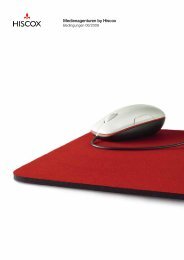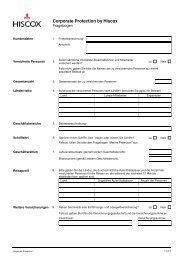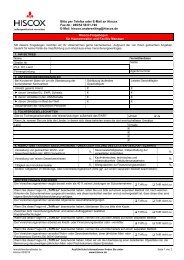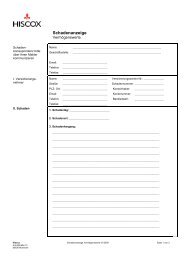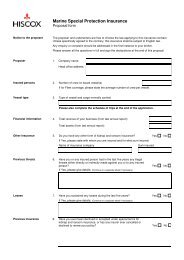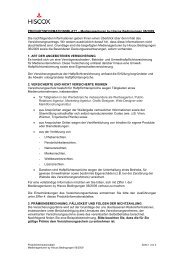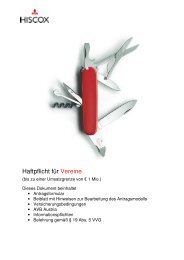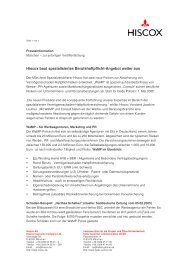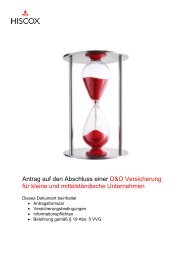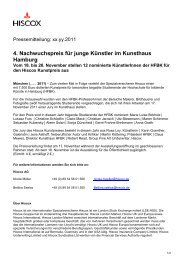Download PDF - Hiscox
Download PDF - Hiscox
Download PDF - Hiscox
Create successful ePaper yourself
Turn your PDF publications into a flip-book with our unique Google optimized e-Paper software.
Notes to the consolidated<br />
financial statements<br />
continued<br />
2 Significant accounting policies continued<br />
2.6 Intangible assets continued<br />
(b) Syndicate capacity<br />
The cost of purchasing the Group’s<br />
participation in the Lloyd’s insurance<br />
syndicates is not amortised but is tested<br />
annually for impairment and is carried at<br />
cost less accumulated impairment losses.<br />
Having considered the future prospects<br />
of the London insurance market, the<br />
Board believe that the Group’s ownership<br />
of syndicate capacity will provide economic<br />
benefits over an indefinite number of<br />
future periods.<br />
(c) State authorisation licences<br />
State authorisation licences acquired<br />
in business combinations are recognised<br />
initially at their fair value. The asset is not<br />
amortised, as the Board considers that<br />
economic benefits will accrue to the Group<br />
over an indefinite number of future periods,<br />
but is tested annually for impairment,<br />
and any accumulated impairment losses<br />
recognised are deducted from the historical<br />
cost amount to produce the net balance<br />
sheet carrying amount.<br />
(d) Rights to customer contractual<br />
relationships<br />
Costs directly attributable to securing<br />
the intangible rights to customer contract<br />
relationships are recognised as an intangible<br />
asset where they can be identified separately<br />
and measured reliably and it is probable<br />
that they will be recovered by directly related<br />
future profits. These costs are amortised on<br />
a straight-line basis over the useful economic<br />
life which is deemed to be 20 years and<br />
are carried at cost less accumulated<br />
amortisation and impairment losses.<br />
(e) Computer software<br />
Acquired computer software licences<br />
are capitalised on the basis of the costs<br />
incurred to acquire and bring into use<br />
the specific software. These costs are<br />
amortised over the expected useful life<br />
of the software of between three and<br />
five years on a straight-line basis.<br />
Internally developed computer software<br />
is only capitalised where the cost can be<br />
measured reliably, the Group intends to<br />
and has adequate resources to complete<br />
development, and where the computer<br />
software will yield future economic benefits<br />
in excess of the costs incurred.<br />
2.7 Financial assets including loans<br />
and receivables<br />
The Group has classified financial assets<br />
as a) financial assets designated at fair<br />
value through profit or loss, and b) loans<br />
and receivables. Management determines<br />
the classification of its financial investments<br />
at initial recognition. The decision by the<br />
Group to designate all financial investments,<br />
comprising debt and fixed income securities,<br />
equities and shares in unit trusts and<br />
deposits with credit institutions, at fair<br />
value through profit or loss reflects the fact<br />
that the investment portfolios are managed,<br />
and their performance evaluated, on a fair<br />
value basis. Regular way purchases and<br />
sales of investments are accounted for<br />
at the date of trade.<br />
Financial assets are initially recognised at<br />
fair value. Subsequent to initial recognition<br />
financial assets are measured as<br />
described below.<br />
Financial assets are de-recognised when the<br />
right to receive cash flows from them expires<br />
or where they have been transferred and the<br />
Group has also transferred substantially all<br />
risks and rewards of ownership.<br />
Fair value for securities quoted in active<br />
markets is the bid price exclusive of<br />
transaction costs. For instruments where no<br />
active market exists, fair value is determined<br />
by referring to recent transactions and other<br />
valuation factors including the discounted<br />
value of expected future cash flows. Fair value<br />
changes are recognised immediately within<br />
the investment result line in the income<br />
statement. An analysis of fair values of financial<br />
instruments and further details as to how they<br />
are measured are provided in note 23.<br />
(a) Financial assets at fair value through<br />
profit or loss<br />
A financial asset is classified into this<br />
category at inception if it is managed<br />
and evaluated on a fair value basis in<br />
accordance with documented strategy,<br />
if acquired principally for the purpose of<br />
selling in the short-term, or if it forms part<br />
of a portfolio of financial assets in which<br />
there is evidence of short-term profit taking.<br />
(b) Loans and receivables<br />
Loans and receivables are non-derivative<br />
financial assets with fixed or determinable<br />
payments that are not quoted on an active<br />
market. Receivables arising from insurance<br />
contracts are included in this category and<br />
are reviewed for impairment as part of the<br />
impairment review of loans and receivables.<br />
Loans and receivables are carried at<br />
amortised cost less any provision for<br />
impairment in value.<br />
56 Notes to the consolidated financial statements <strong>Hiscox</strong> Ltd Report and Accounts 2009<br />
2.8 Cash and cash equivalents<br />
The Group has classified cash deposits<br />
and short-term highly liquid investments<br />
as cash and cash equivalents. These assets<br />
are readily convertible into known amounts<br />
of cash and are subject to inconsequential<br />
changes in value. Cash equivalents are<br />
financial investments with less than three<br />
months to maturity at the date of acquisition.<br />
2.9 Impairment of assets<br />
Assets that have an indefinite useful life are<br />
not subject to amortisation and are tested<br />
annually or whenever there is an indication<br />
of impairment. Assets that are subject to<br />
amortisation are reviewed for impairment<br />
whenever events or changes in circumstances<br />
indicate that the carrying amount may not<br />
be recoverable.<br />
(a) Non-financial assets<br />
Objective factors that are considered when<br />
determining whether a non-financial asset<br />
(such as goodwill, an intangible asset<br />
or item of property, plant and equipment)<br />
or group of non-financial assets may be<br />
impaired include, but are not limited to,<br />
the following:<br />
adverse economic, regulatory<br />
or environmental conditions that<br />
may restrict future cash flows and<br />
asset usage and/or recoverability;<br />
the likelihood of accelerated<br />
obsolescence arising from the<br />
development of new technologies<br />
and products; and<br />
the disintegration of the active<br />
market(s) to which the asset is related.<br />
(b) Financial assets<br />
Objective factors that are considered when<br />
determining whether a financial asset or<br />
group of financial assets may be impaired<br />
include, but are not limited to, the following:<br />
negative rating agency announcements<br />
in respect of investment issuers,<br />
reinsurers and debtors;<br />
significant reported financial difficulties<br />
of investment issuers, reinsurers<br />
and debtors;<br />
actual breaches of credit terms<br />
such as persistent late payments<br />
or actual default;<br />
the disintegration of the active<br />
market(s) in which a particular asset<br />
is traded or deployed;<br />
adverse economic or regulatory<br />
conditions that may restrict future cash<br />
flows and asset recoverability; and<br />
the withdrawal of any guarantee from<br />
statutory funds or sovereign agencies<br />
implicitly supporting the asset.<br />
(c) Impairment loss<br />
An impairment loss is recognised for the<br />
amount by which the asset’s carrying



